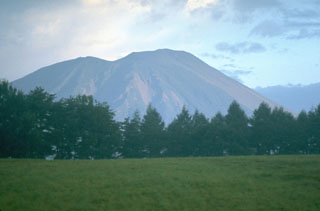Report on Iwatesan (Japan) — September 1998
Bulletin of the Global Volcanism Network, vol. 23, no. 9 (September 1998)
Managing Editor: Richard Wunderman.
Iwatesan (Japan) Nearby M 6.2 earthquake on 3 September, but volcano still slumbering
Please cite this report as:
Global Volcanism Program, 1998. Report on Iwatesan (Japan) (Wunderman, R., ed.). Bulletin of the Global Volcanism Network, 23:9. Smithsonian Institution. https://doi.org/10.5479/si.GVP.BGVN199809-283240
Iwatesan
Japan
39.853°N, 141.001°E; summit elev. 2038 m
All times are local (unless otherwise noted)
A strong earthquake occurred 10 km SW of the summit of Iwate volcano at 1658 on 3 September. The Richter magnitude was 6.1 and the depth ~7 km. The mechanism was E-W compression on a reverse fault. A N-S-trending surface rupture appeared, despite the event's non-extreme magnitude. The aftershock area resulting from the earthquake differed from typical earthquakes on Iwate and the relationship between the earthquake and the volcano, if any, is not understood. This was the largest earthquake since August 1996 when a M 5.9 tremor struck.
A 3 September Reuters news article mentioned that a powerful earthquake took place, centered in the ski resort area of Shizukuishi, a mountainous region near Iwate volcano. The report claimed the epicenter was 5 km underground and police said that the event slightly injured at least nine people.
Geological Summary. Viewed from the east, Iwatesan volcano has a symmetrical profile that invites comparison with Fuji, but on the west an older cone is visible containing an oval-shaped, 1.8 x 3 km caldera. After the growth of Nishi-Iwate volcano beginning about 700,000 years ago, activity migrated eastward to form Higashi-Iwate volcano. Iwate has collapsed seven times during the past 230,000 years, most recently between 739 and 1615 CE. The dominantly basaltic summit cone of Higashi-Iwate volcano, Yakushidake, is truncated by a 500-m-wide crater. It rises well above and buries the eastern rim of the caldera, which is breached by a narrow gorge on the NW. A central cone containing a 500-m-wide crater partially filled by a lake is located in the center of the oval-shaped caldera. A young lava flow from Yakushidake descended into the caldera, and a fresh-looking lava flow from the 1732 eruption traveled down the NE flank.
Information Contacts: Yukio Hayakawa, Faculty of Education, Gunma University, Aramaki, Maebashi 371, Japan; Reuters Limited, 1700 Broadway, New York, NY 10019 USA (URL: http://www.reuters.com/).

